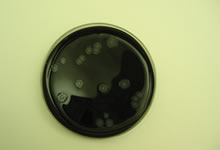Legionella
 Legionella is a bacterium that naturally occurs in freshwater environments worldwide, including streams, lakes, and mud. Legionella also has the ability to colonize in man-made water systems like cooling towers, building water systems, evaporative condensers, and recreational structures such as jacuzzis and fountains.
Legionella is a bacterium that naturally occurs in freshwater environments worldwide, including streams, lakes, and mud. Legionella also has the ability to colonize in man-made water systems like cooling towers, building water systems, evaporative condensers, and recreational structures such as jacuzzis and fountains.
Legionella pneumophila is the causative agent of legionellosis which includes Legionnaires' disease and Pontiac fever; Legionnaires' disease is characterized by pneumonia, while Pontiac fever is characterized by a less severe influenza-like illness. Legionellosis is acquired when water containing Legionella becomes aerosolized and is inhaled.
There are at least 50 species and 70 serogroups of Legionella identified to date. Identification of Legionella to species and serogroup differs from typical bacterial identification, requiring specialized media, culture conditions and identification techniques.
SGS Forensic Laboratories (SGSFL) can analyze your samples for the presence of Legionella, using both the traditional culture and DFA methodology as well as the recently developed PCR method.
Traditional vs PCR
Traditional analysis for Legionella involves isolating the bacteria on specialized media and utilizing the direct fluorescent antibody (DFA) staining method. This process isolates and identifies only viable Legionella and can identify Legionella to serogroupings.
PCR analysis quantifies all Legionella in a sample, both viable and non-viable. Results for Legionella species identification can be obtained quickly, allowing faster reaction time.
There are advantages and disadvantages to both methods. The traditional culturing method offers the advantage of only quantifying viable Legionella in the sample (as non-viable cells do not pose a health risk). However, culturing and DFA are both more time consuming and more expensive than PCR. With PCR, results can be obtained in 24 hours, although both viable and non-viable results are reported, and serogroups are not identified.
Combining both methods may be the ultimate solution. Analysis with PCR can detect the presence of Legionella rapidly, avoiding a potential delay of two weeks waiting for results. Culturing can then verify viability and identify the species and serogroups of the Legionella isolated. This approach could also keep costs down, utilizing viable culture methodology only for samples that test positive for Legionella.
